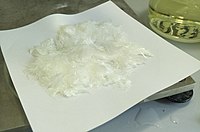
Photo from wikipedia
The increasing needs of drinking water due to population growth requires seeking for new tap water sources. However, these large-scale tap water sources are oftentimes abundant with dissolved natural organic… Click to show full abstract
The increasing needs of drinking water due to population growth requires seeking for new tap water sources. However, these large-scale tap water sources are oftentimes abundant with dissolved natural organic matter (NOM), such as tannic acid issue causing color in water. If not removed at the source locations beforehand, NOM would impact coagulation and flocculation unit, and/or become precursors to prompt the production of disinfectant by-products after chlorination in drinking water treatment. This study focuses on developing and testing a suite of cost-effective, scalable, adaptable, and sustainable sorption media that can be implemented near the source locations of tap water as a pretreatment option to remove color for a long-distance interbasin transfer. Within the five tested sorption media, a media recipe of Zero-valent-Iron and Perlite Based Green Sorption Media (ZIPGEM) with ingredients of 85% sand, 5% clay, 6% zero-valent-iron (ZVI) and 4% perlite by volume stood out as the best option for color removal. Findings showed that ZIPGEM can maintain a color removal of ∼77% for about 14,080 min, maintaining the effluent concentration below 40 Pt-Co units given the influent condition of 175 ± 10 Pt-Co units. A recovery on the adsorption capacity of ZIPGEM was observed around 40,000 min due to synergetic effects among several different ingredients of recycled ZVI, clay, sand, and perlites. ZIPGEM can be applied to industrial wastewater treatment for dye removal as well.
Journal Title: Environmental research
Year Published: 2022
Link to full text (if available)
Share on Social Media: Sign Up to like & get
recommendations!